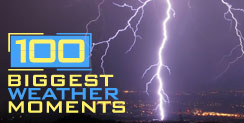| 100 Biggest Weather Moments | |
|---|---|
 100 Biggest Weather Moments' title screen | |
| Starring | Host: Harry Connick, Jr. Other: Various celebrity commentaries, The Weather Channel's on-air meteorologists |
| Country of origin | United States |
| No. of episodes | 5 |
| Production | |
| Running time | approx. 1 hour per episode |
| Original release | |
| Network | The Weather Channel |
| Release | April 15 – April 19, 2007 |
100 Biggest Weather Moments was a 2007 five-part miniseries on The Weather Channel, that premiered on Sunday, April 15, and aired nightly through Thursday, April 19, the biggest documentary effort in The Weather Channel's 25-year history. [1]
Contents
- Episode details
- Weather moments
- Episode #1
- Episode #2
- Episode #3
- Episode #4
- Episode #5
- Personalities include
- Promotion
- See also
- References
- External links
The series was hosted by Harry Connick, Jr. and counted down the top weather-related events (mostly from the United States) with commentary from various celebrities. The collection of weather moments was the work of more than 120 meteorologists. [2]
A second version of Top 100 Weather Moments premiered on June 14, 2020 with five episodes running through July 12, 2020. [3] [4]